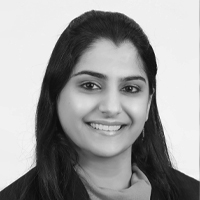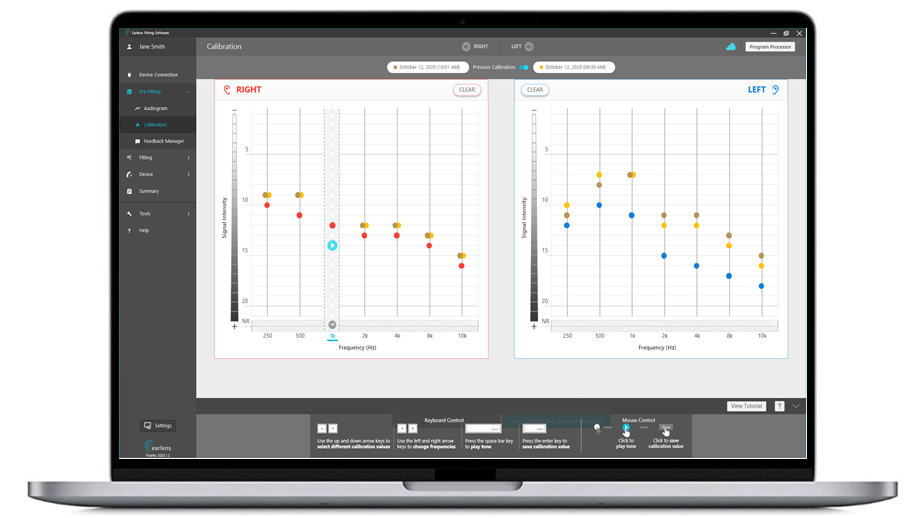Busy Day? New Earlens Fidelity™ Fitting Software Provides a Smooth and Fast Fitting Experience

AudiologyOnline: Before we get into the new fitting software, can you provide an overview of the Earlens contact hearing solution and direct drive technology?
Pragati: Earlens presents an innovative solution to the treatment of mild to severe sensorineural hearing loss. We have just been recognized as one of the 100 best inventions of 2020 by Time magazine! The Earlens is a contact hearing device - that is, a lens is custom-built to stay in contact with an individual’s eardrum. Instead of producing an amplified signal in the ear canal, Earlens directly drives the eardrum to produce usable and audible amplification from 125-10,000 Hz. By directly driving the eardrum (i.e., direct drive technology), Earlens is able to overcome the impedance of the middle ear and efficiently transmit energy over a wider bandwidth than traditional acoustic hearing aids. Earlens can therefore provide large gains in higher frequencies without any acoustic feedback. In fact, Earlens is a hearing aid that works amazingly well without actually producing sound! Patients do not experience occlusion as vents can be made as large as allowed by the anatomy. Earlens can deliver rich lows and crisp highs with a widely vented fitting making speech and music listening much more enjoyable. Early studies such as Gantz et al. (2017) demonstrated the safety and efficacy of the device. Since then, a growing number of publications have demonstrated the enhanced sound quality, streaming quality, broadband amplification, and speech-in-noise benefits of this technology with patients. A few of these studies include: Vaisberg et al., 2020; Vasuki et al., 2020; Arbogast et al., 2019; and Levy et al., 2015. This is not an exhaustive list of studies – but the evidence is clear that broadband amplification delivered by directly driving the eardrum enhances patients’ hearing aid experience.
AudiologyOnline: Thanks for that overview. So, what is new about Earlens FidelityTM fitting software?
Pragati: Everything about Earlens is unique – the product, its functioning, and the care delivery model involving two highly trained professionals. As such, some common concepts of how it works and how to program it are different from conventional acoustic hearing aid technology. Keeping this in mind, Earlens engaged with clinicians and developers to design a fitting software that is intuitive and robust while guiding the clinician through an effortless fitting. Along with design and usability changes, the back-end of the software was improved to facilitate future upgrades. The result was an elegant software solution that speaks to Earlens’ value proposition of delivering clear sound through a fitting that is verified within the fitting software every time. The new Earlens FidelityTM ® fitting software makes the process of fitting this revolutionary hearing solution intuitive so that, as this new technology grows in the marketplace, clinicians can quickly grow confident with successful fittings.
AudiologyOnline: How is Earlens FidelityTM different than the previous fitting software?
Pragati: Earlens FidelityTM user interface has been completely updated from our previous fitting solution. We refined workflows and re-designed screens to make key functions more accessible with built-in tutorials where needed. Earlens FidelityTM was aesthetically designed to allow for user flexibility while ensuring consistency and logical progression from one fitting step to another. We often say to our customers – “Earlens is a silent hearing aid”. For fitting this ‘silent’ hearing aid, a step called calibration is necessary. Calibration allows for in-situ verification of gains produced in the patient’s ear. This important step verifies the fitting within the fitting software itself and is crucial for confirming usable amplification that is audible across a broad bandwidth. With Earlens FidelityTM, this step has been simplified, allowing the clinician to have a quick snapshot of current as well as prior functioning status of the device. Earlens FidelityTM contains wireless programming and improved environmental noise reduction feature from the prior version of software.
In addition, some exciting new features in Earlens FidelityTM include:
- A new vertical workflow - that is, a navigation bar in which options are laid out from top to bottom following the sequence of steps for performing a fitting
- Calibrator aligned with audiogram with an interactive calibration tutorial and help center
- Ability to view up to 2 prior calibrations
- New built-in patient counseling tools

Earlens FidelityTM fitting software
AudiologyOnline: A lot of new features of the software are centered around calibration, can you explain more about what is calibration and why it is important?
Pragati: Absolutely – this is a question that I am often asked. Earlens is a hearing aid that produces no sound. Calibration is needed so that the Earlens system knows how much signal is needed to move the eardrum to produce an equivalent amount of sound. During the process of calibration, a clinician presents tones using the fitting software and measures a patient’s thresholds at various frequencies. Each patient’s middle ear efficiency and device performance is unique. Calibration provides a correction factor to account for this variability in middle ear efficiency and device performance. Calibration serves as the direct drive equivalent to real ear measurements in acoustic hearing aids. This step ensures that the fitting (i.e. gains prescribed for a patient’s hearing loss) are automatically verified every time calibration is run. The step is self-contained within the fitting software and made smoother with the release of Earlens FidelityTM The new feature of viewing prior calibrations allows the audiologist to monitor functioning of the device over time. Since calibration is exclusive to Earlens fittings, interactive tutorials and help centers are built into the software to refresh clinicians’ memories and provide a quick refresher at their fingertips.
AudiologyOnline: What are the new counseling tools within Earlens FidelityTM?
Pragati: Earlens FidelityTM offers a special mode for aided sound field testing called the Functional Gain Mode. Although calibration effectively verifies an Earlens fitting, Functional Gain measures can be used to confirm that the individual’s gain settings will result in useful audibility at suprathreshold levels. With a newly designed Audiogram and Real-World sounds screen, Earlens FidelityTM facilitates counseling to the benefits of broad spectrum amplification. Clinicians can illustrate increased audibility of high frequency speech sounds by entering aided threshold data for Earlens and comparing that with aided thresholds for conventional hearing aid devices. Clinicians can also customize patient reports to objectively illustrate the Earlens benefit at a glance.
AudiologyOnline: What are some workflow changes that allow for a smooth fitting with Earlens FidelityTM ®?
Pragati: Earlens is the only hearing aid technology that provides extended high frequency amplification up to 10 kHz and entering 10 kHz hearing thresholds into the software allows for a more accurate gain prescription at that frequency. Since this step is exclusive to Earlens fittings, Earlens FidelityTM automatically takes the clinician to audiogram screen for new fittings thereby reminding clinicians to enter the 10 kHz hearing thresholds into the software. For follow-up fittings, Earlens FidelityTM reinforces that calibration must be run by navigating the clinician to calibration screen. The button for next logical step in fitting is highlighted by default, thereby guiding the clinician towards a successful fitting.

Calibration screen within the Earlens FidelityTM ® fitting software
AudiologyOnline: What happens to the former fitting software?
Pragati: Earlens FidelityTM will replace prior Earlens fitting software (popularly known as ELF) for Inductive Earlens products. No further upgrades will be released for previous software versions. Earlens FidelityTM will be required to program the Earlens Inductive Contact Hearing solution, and future releases of the Earlens devices. Fine tunings for legacy Earlens devices (i.e. Earlens Light-driven Hearing Aid) can still be performed through the ELF software. Support for ELF software will be available until the rollout of Earlens FidelityTM / Earlens Inductive Contact Hearing Solution is complete.
AudiologyOnline: Have you received any feedback from clinicians?
Pragati: Yes! Sites that are early adopters of Earlens FidelityTM have unequivocally responded that the new software is intuitive and exceeds their expectations. Clinicians report that they are impressed by the new enhancements, especially when conducting calibration, as this step is unique to the Earlens fitting process. The improved design of the software fulfills the experience of fitting a premium hearing aid.
AudiologyOnline: Where should people go for more information?
Pragati: For more information, people can check out the newest continuing education (CE) courses from Earlens, including:
Recorded Webinar: The Earlens Difference. Why Contact Drive Succeeds Where Acoustic Devices Fail, presented by Drew Dundas, PhD, FAAA
Recorded Webinar: Step by Step: The Audiologist’s Guide to Fitting the Inductive Earlens Contact Hearing Solution, presented by Pragati Rao Mandikal Vasuki, PhD
Recorded Webinar - coming soon, available December 18, 2020: Silent Hearing Aid: Common Hearing Aid Concepts Through a New Lens
The latest courses, as well as videos and other resources, can be found on Earlens Partner Page on AudiologyOnline. Professionals can also visit the Earlens website, www.earlens.com
References/Additional Reading
Arbogast, T.L., Moore, B.C., Puria, S., Dundas, D., Brimacombe, J., Edwards, B., & Levy, S.C. (2019). Achieved gain and subjective outcomes for a wide-bandwidth contact hearing aid fitted using CAM2. Ear and Hearing, 40(3), 741.
Gantz, B.J., Perkins, R., Murray, M., Levy, S.C., & Puria, S. (2017). Light-driven contact hearing aid for broad-spectrum amplification: safety and effectiveness pivotal study. Otology & Neurotology, 38(3), 352.
Levy, S.C., Freed, D.J., Nilsson, M., Moore, B.C., & Puria, S. (2015). Extended high-frequency bandwidth improves reception of speech in spatially separated masking speech. Ear and Hearing, 36(5), e214.
Vaisberg, J., Folkeard, P., Levy, S., Dundas, D., Agrawal, S., & Scollie, S. (2020). Sound quality ratings of amplified speech and music using a direct drive hearing aid: Effects of bandwidth. Otology & Neurotology. doi: 10.1097/MAO.0000000000002915
Vasuki, P. R. M., Eskridge-Mitchell, E., & Dundas, D. (2020). Full bandwidth streamed audio with an open-fit: Is it possible? Available at www.hearingreview.com

